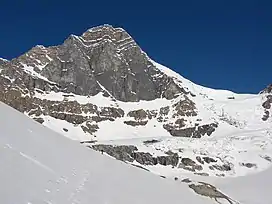Mount Woolley
Mount Woolley is a mountain in Alberta, Canada, located in the Sunwapta River Valley of Jasper National Park, 1½ km south of Diadem Peak and is part of Winston Churchill Range of the Canadian Rockies.
| Mount Woolley | |
|---|---|
 E face of Wooley | |
| Highest point | |
| Elevation | 3,405 m (11,171 ft)[1][2] |
| Prominence | 565 m (1,854 ft)[3] |
| Parent peak | Mount Alberta (3619 m) |
| Listing | Mountains of Alberta |
| Coordinates | 52°17′50″N 117°25′31″W[4] |
| Geography | |
 Mount Woolley Location in Alberta  Mount Woolley Mount Woolley (Canada) | |
| Country | Canada |
| Province | Alberta |
| Protected area | Jasper National Park |
| Parent range | Winston Churchill Range |
| Topo map | NTS 83C6 Sunwapta Peak[4] |
| Climbing | |
| First ascent | July 28,1925, by a Japanese team (Six Japanese men including Yūkō Maki and three men from Switzerland) |
| Easiest route | rock/snow climb |
History
The mountain was named in 1898 by J. Norman Collie after Herman Woolley. Woolley, a former football player, climbed extensively with Collie during his 1898 and 1902 expeditions into the Canadian Rockies.[1]
The first ascent was made in 1925 by a Japanese team consisting of S. Hashimoto, H. Hatano, T. Hayakawa, Y. Maki, Y. Mita and N. Okabe. They were guided by Hans Fuhrer, H. Kohler and J. Weber.[1]
Geology
Mount Woolley is composed of sedimentary rock laid down from the Precambrian to Jurassic periods.[5] Formed in shallow seas, this sedimentary rock was pushed east and over the top of younger rock during the Laramide orogeny.[6]
Climate
Based on the Köppen climate classification, Mount Woolley is located in a subarctic climate zone with cold, snowy winters, and mild summers.[7] Temperatures can drop below -20 °C with wind chill factors below -30 °C.
References
- "Mount Woolley". cdnrockiesdatabases.ca. Retrieved 2007-09-10.
- "Topographic map of Mount Woolley". opentopomap.org. Retrieved 2023-07-18.
- "Mount Woolley". Bivouac.com. Retrieved 2007-09-10.
- "Mount Woolley". Geographical Names Data Base. Natural Resources Canada. Retrieved 2023-07-18.
- Belyea, Helen R. (1960). The Story of the Mountains in Banff National Park (PDF). parkscanadahistory.com (Report). Ottawa: Geological Survey of Canada. Archived (PDF) from the original on 2015-10-02. Retrieved 2019-09-13.
- Gadd, Ben (2008). Geology of the Rocky Mountains and Columbias.
- Peel, M. C.; Finlayson, B. L. & McMahon, T. A. (2007). "Updated world map of the Köppen−Geiger climate classification". Hydrol. Earth Syst. Sci. 11: 1633–1644. ISSN 1027-5606.